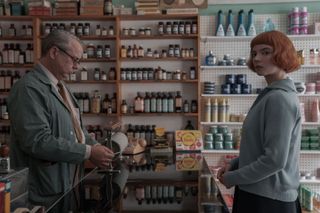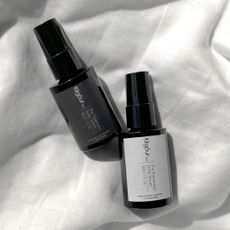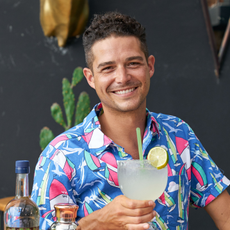

Warning: This story contains spoilers for The Queen's Gambit. Drug addiction is not a new concept in prestige television, but Beth Harmon's substance abuse in Netflix's new miniseries The Queen's Gambit does look rather different from that of her peers in similarly gritty shows. For one thing, the chess prodigy's habit is kickstarted in her childhood due to the orphanage she is sent to after her mother's death; every day, the orphanage's residents line up to receive their "vitamins"—two pills, one red and one green. For another, throughout much of the series, the drugs seemingly help, rather than hurt, Beth's pursuit to become a chess grandmaster by "clearing her head" and allowing her to map out entire games on the ceiling of her room.
It doesn't take long for Beth (played in her youth by Isla Johnston) to get hooked on the green pills, which are eventually revealed to be tranquilizers. And while it seems that Beth's addiction will end with the laissez-faire attitude that allowed orphanages to drug their wards—barring her last-ditch effort to break into the medicine room to swallow as many of the leftover, now-illegal pills as possible—they reappear several years later. Beth's adoptive mother (Marielle Heller) relies on the drug, which she refers to as her "tranquility medicine," to deal with the stresses of her unfulfilled dreams and failing marriage. Beth, now played by Anya Taylor-Joy, quickly begins siphoning out handfuls of the pills to keep for herself, plunging her immediately back into the throes of addiction.
So, what exactly are these orphanage- and mom-approved pills? Here's everything we know about the "green pills" in The Queen's Gambit.
Are the green "tranquility" pills real?
In the show, the pills are called Xanzolam, which is not a real drug. However, as Newsweek reports, Xanzolam bears many striking similarities to chlordiazepoxide, a benzodiazepine that was marketed as Librium. It became hugely popular in the 1960s, when The Queen's Gambit is set, and was packaged in two-toned green capsules similar to Xanzolam; in fact, at one point, when Beth is in Mexico City for a chess tournament and has run out of Xanzolam, she is given Librium at a local pharmacy. After being patented in 1958 and approved for medical use in 1960, Librium was prescribed liberally as a cure for anxiety, insomnia, and withdrawal symptoms. This widespread usage came to a head in the mid-1970s, when the DEA instated stricter regulations for Librium due to its overprescription and high potential for misuse.
These early tranquilizers were reportedly heavily marketed to young women and housewives who were physically healthy but, likely due to a sense of dissatisfaction with their positions in mid-20th century America, were struggling to cope mentally. Rather than supporting them in, oh, I don't know, securing financial independence or pursuing high-status careers outside of the home, physicians at the time instead offered them bottle after bottle of sedatives. Tomayto, tomahto.

Where did the idea for Beth's addiction come from?
Walter Tevis, who wrote the 1983 novel on which the Netflix series is based, drew on many of his own experiences and relationships to build Beth's world, from his time as an amateur chess player to the many "brainy women" in his life. Beth's addiction to Xanzolam was no different. In an interview with The New York Times in 1983, Tevis described how writing about Beth's substance abuse helped him address his own experiences with drug use.
"When I was young, I was diagnosed as having a rheumatic heart and given heavy drug doses in a hospital. That's where Beth's drug dependency comes from in the novel," Tevis said. "Writing about her was purgative. There was some pain—I did a lot of dreaming while writing that part of the story. But artistically, I didn't allow myself to be self-indulgent."
Stay In The Know
Marie Claire email subscribers get intel on fashion and beauty trends, hot-off-the-press celebrity news, and more. Sign up here.
Additionally, benzodiazepine addiction became hugely widespread in the mid-20th century, even as scientists failed to identify their addictive properties until years after their debut, when dependence and overprescription were already rampant. Per the American Addiction Centers, "As with many drugs that have psychoactive effects, people quickly began to note the euphoria that resulted from taking these common medicines. ... Whether through this recreational abuse or through abusing the drugs for their treatment effects, benzos have the potential to cause tolerance, dependence, and addiction."
Did orphanages really drug children?
Sadly, yes. A 2018 report from BuzzFeed News alleged that among the abuses of many orphanages in the U.S. and Canada throughout the middle of the 20th century was the common use of intravenous sedatives to keep children calm. Additionally, several reports released in the last few years have found that orphanages in countries including Russia, Ukraine, and Romania have used powerful drugs to sedate their wards for many decades past the point in The Queen's Gambit in which Beth's Kentucky orphanage is ordered to stop doing so.
And as recently as 2018, a federal judge confirmed that government officials had been forcibly injecting tranquilizers into migrant children being held at the border in facilities as family separations continue. The judge ordered the officials to stop administering the psychotropic drugs without parental consent, except in emergency cases.
RELATED STORIES


Andrea Park is a Chicago-based writer and reporter with a near-encyclopedic knowledge of the extended Kardashian-Jenner kingdom, early 2000s rom-coms and celebrity book club selections. She graduated from the Columbia School of Journalism in 2017 and has also written for W, Brides, Glamour, Women's Health, People and more.
-
 A Healthy Scalp Is the Secret to the Best Hair of Your Life
A Healthy Scalp Is the Secret to the Best Hair of Your LifeSponsor Content Created With KilgourMD
By Emma Walsh Published
-
 Jennifer Lopez Puts Her Navy Outfit Into Overdrive With a Matching Birkin
Jennifer Lopez Puts Her Navy Outfit Into Overdrive With a Matching BirkinIs it really a J.Lo outfit without this particular purse?
By India Roby Published
-
 Will Prince Archie and Princess Lilibet Appear in Prince Harry and Meghan Markle’s Two New Netflix Series?
Will Prince Archie and Princess Lilibet Appear in Prince Harry and Meghan Markle’s Two New Netflix Series?Filming for both shows—about polo and cookery—began this month.
By Rachel Burchfield Published
-
 The Best Bollywood Movies of 2023 (So Far)
The Best Bollywood Movies of 2023 (So Far)Including one that just might fill the Riverdale-shaped hole in your heart.
By Andrea Park Published
-
 ‘Bachelor in Paradise’ 2023: Everything We Know
‘Bachelor in Paradise’ 2023: Everything We KnowCue up Mike Reno and Ann Wilson’s “Almost Paradise."
By Andrea Park Last updated
-
 Who Is Gerry Turner, the ‘Golden Bachelor’?
Who Is Gerry Turner, the ‘Golden Bachelor’?The Indiana native is the first senior citizen to join Bachelor Nation.
By Andrea Park Last updated
-
 ‘Virgin River’ Season 6: Everything We Know
‘Virgin River’ Season 6: Everything We KnowHere's everything we know on the upcoming episodes.
By Andrea Park Last updated
-
 Kim Cattrall Didn't See or Speak to Her Costars When Filming 'And Just Like That' Cameo
Kim Cattrall Didn't See or Speak to Her Costars When Filming 'And Just Like That' CameoThat's some type of commitment.
By Iris Goldsztajn Published
-
 The 65 Best K-Dramas You'll Be Completely Hooked On
The 65 Best K-Dramas You'll Be Completely Hooked OnWait, how is it already 2 a.m.?
By Quinci LeGardye Last updated
-
 Selena Gomez Revealed Meryl Streep Is Joining 'Only Murders in the Building' Season 3
Selena Gomez Revealed Meryl Streep Is Joining 'Only Murders in the Building' Season 3Fans are losing it.
By Iris Goldsztajn Published
-
 The 60 Best Musical Movies of All Time
The 60 Best Musical Movies of All TimeAll the dance numbers! All the show tunes!
By Amanda Mitchell Last updated